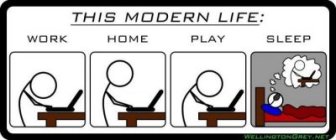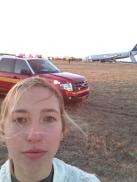Category Archives: EM Development
The Perversion of Social Media
Posted by tjlasagna
I read an article today about a fatal accident that occurred in the Dallas/Fort Worth, TX area yesterday (6/3/2014). The article focused somewhat on the accident itself, but moreso on the reaction of an off-duty responder who noticed bystanders using their phones to capture footage of the accident, rather than assisting. (You can find the aforementioned article here in a new window if you’re interested in its content before reading further.)
The article shares the point of view of Lt. Anthony Williams (the off-duty responder) who attempted to assist in the incident as he pulled on-scene to a burning car where reportedly two people died, burned beyond recognition. He recalled onlookers pointing their phones at the scene in his peripheral vision and called it “the perversion of social media” that they would be more interested in capturing video footage instead of helping the victims. That phrase caught my attention and left me wondering…is that where social media has now led the public in emergency situations?
Upon further investigation, I found that even being a part of disaster situations isn’t enough to distract from the need to immediately share those experiences on social media. You can search for “selfie after plane crash” or “selfie after stabbed” and there are, in fact, results that turn up by the plenty. Another video seen today made light of a teenager with his dad who saw a semi-truck stuck on some rail road tracks. As a train approached, they began recording the unfolding incident and the video was soon uploaded to YouTube and shared across the web. And the teenager literally stood in the middle of the debris saying, “is this real life??”
So what is encouraging the public to make these choices during disaster situations? I would argue it’s actually a list on influences that should be considerably eye-opening for my fellow emergency management focused friends, especially in their planning and response strategies.
The public isn’t empowered enough to act during disaster.
We spend a lot of our time telling people what they can’t touch, where there can’t go, what can’t do, what they can’t say, or generally protecting whatever “territory” we feel is ours that it’s no wonder community members look a a crisis unfolding and feel helpless to do anything. For the lay community member, what is outside of their daily job function is outside of their “basement” level thinking – the kind of thinking that happens naturally and automatically in response to a stressful situation. (I should note that concept is learned from a 2011 meta-leadership seminar I attended!) For the officer in the story above, jumping into response mode was the obvious choice. For the other bystanders, they’re so often made to feel that the only thing they can and should be allowed to do is wait patiently. Is this all encompassing, of course not. Is it pretty common? Well, the story above is one of many examples.
The public experiences fear, and fear can be paralyzing.
One of my favorite books related to emergency management was Amanda Ripley’s Unthinkable. It’s a great read, not too complicated and very eye opening about the reactions people have to disasters. Plane going down? Everyone shares a laugh. Building burning down? Let’s wait and see what’s REALLY going to happen. Fear paralyzes people, removes their normal thought process and makes excuses against what they’re experiencing to put it in a more digestable format. When you’re afraid, the ability to make rational decisions is quickly diminished, and that lack of recognition and decision making is paralyzing. What do you do when you don’t know what to do? Which leads me to my next thought…
The public has a disconnect with crises.
We’re not empowering them, and without knowledge or training there is fear. And where there is fear and inexperience there is a disconnect from what a crisis really is: a bad situation that can happen to anyone, anytime that is completely dependent on who will step up to handle it. The 24-7 news-like exposure folks have to disaster in our culture so often puts them in a realm of automatic disconnect to the reality of it that when it’s in front of them, it automatically turns into almost a movie-like experience. As long as nothing happens to someone, they will believe that nothing will happen to them. And when it happens to others, it’s a very unfortunate, very impersonal scene that they haven’t been given a role to play in.
The public processes information in a very unprecedented way.
There was a point in my life that if I didn’t know what to do, I’d open my phone and click on Twitter. Or I’d sit down to do a task at my computer and type “Faceb…” before I realized that wasn’t what I wanted to be doing. Am I proud of this fact? No way! “Recovering” is a more accurate description. The point is, social media is a decision A LOT of people make when we’re in the basic, “basement” way of thinking. Nowadays, events haven’t been experienced until they’ve been shared. They’re not processed unless they’re discussed. We use social media to document information, to show we’re the first to know it, to receive empathy, to alert that we’re okay, to share the unbelievable. We use social media to experience that which simply “can’t be happening to me” during the times we “can’t do anything about it” because it isn’t real life until we can go through our notes with those we connect with.
Yes, I realize I’m speaking in absolutes, recognizing this is a thought for a general population and not all-encompassing. But you get the idea. It is a terrible tragedy that anyone should lose their life needlessly in disaster. It’s even worse when there are things that can be done that aren’t done, whether for ones self (evacuating, preparing, sheltering…) or for others.
So what are you going to change about your message and your interactions with your community to humanize the emergency management field, empower your citizens and foster a whole community response to keep these things from happening any more?
Tweet #BiggerThanMyself or mention me @tjlasagna if you have some suggestions. If this is a topic you’d like to see researched further, please also let me know.
-Tanya
Strengths, Weaknesses and Finding your fit in EM
Posted by tjlasagna
It took me a long time to figure out the things I was good at, and the things I wasn’t so good at. Or maybe, rather, it took me a long time to accept it. Maybe that’s because it’s easy to see what you’re bad at, albeit tough to admit, and hard to give yourself credit for what you do well.

Kind of hoping the arm on the left represents my strengths…
For me, I know I’m great at developing new concepts and starting them off, I’m bad at following through and completing them. I’m sure of my decisions when directing others, but doubt my decisions when I’m the one pulling the trigger. I enjoy being in the middle of action and long for that hands-on response, but know I’m most useful waiting until there’s a role and a function I can fulfill. I have strengths and weaknesses, but in the end all I want is to do is provide an effective response. I know I’m talking a lot about me, but I do so because I want to exemplify a very important task that we all, including myself, need to do.
As folks involved in disaster, we have to recognize our weaknesses and our strengths. Not just know…recognize. And then plan to deal with them.
Don’t get me wrong, this statement is true for everyone. But the reason it is so critical for our field is because emergency management drives passion and excitement, and those things can cause us to enter superhero mode (and yes, I believe everyone I work with is a superhero) without realizing where we’re really needed.
When it comes to response, so many people want to save the day as soon as it is understood the day will need saving. It is one of the things that make our career field so different from many others…when our day gets worse (i.e. a disaster strikes), we can’t stop working. We don’t want to stop working. Our pulses race, our instincts take over and all we want to do is protect life, property and everything in between.
The problem with this is we are at great risk for doing a disservice to that which is motivating us. I want to protect my community, but I can’t if I’m burnt out. I can’t do that if I’m duplicating someone else’s efforts at the same time as them or if I haven’t recognized where I can do the most good. We want to keep working and want to fulfill every task because we want to protect everyone, but by not recognizing our strengths and weaknesses, we are not doing what is best for the community.

Can’t…stop…working…!
I have a special place in my heart for public information…it was my introduction to the world of emergency management over six and a half years ago. I knew my strength was working with the press because I had been on the other side of that relationship, but my excitement became my weakness because I’d develop tunnel vision when I was on the ground.
With the help of some very good mentors and the stress of real-life application, I realized I could easily become lost in the PIO role, and lost people are at risk for making bad decisions and being ineffective.
By recognizing my weakness, I was able to develop tools in order to manage it and then step back and figure out what my strength was in the same arena and learn how to make a true difference. I used to feel bad realizing that something I loved deeply wasn’t the best fit for me in its active form. Even now, I hate admitting this on my blog because I wouldn’t want anyone to lose faith in the assistance I can provide. But weaknesses are only disabling when you don’t make a plan to adjust to them or let them lead you to your other strengths.

Yep, still hate admitting it!
Now, wherever I am involved in my broader level of emergency response, public information is addressed where it may often be neglected. I’m great at Joint Information Center support and evaluation and found that social media is a niche I am most at ease with…a largely uncharted territory in EM.
I wanted to share this piece of my journey in identifying some of my weaknesses and strengths because once I finally did, my effectiveness in emergency management was altered in such a positive way. You may be amazing at on-scene media management and speaking for your agency. Or maybe you are the BEST at training others. Or an invaluable asset with your ability to track supplies or finances. Perhaps you are level-headed in disaster and perform flawlessly as boots on the ground, providing those critical services that literally save lives.
Whatever it is that you are the best at, give yourself credit for it. And then stop letting your weaknesses get in the way of finding your perfect fit.
